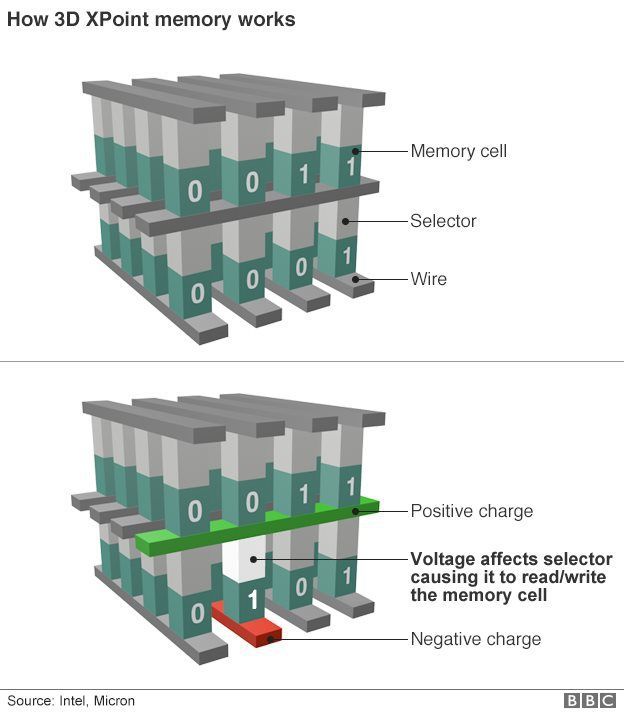Technology 3D XPoint – high performance and exceptional reliability
In relation to technology in general, and memory technology in particular, there are many different specifications that need to pay attention. 3D XPoint technology offers many advantages for certain applications related to high performance. The examples presented below, to help visualize these benefits.
Intel and Micron * represent a new memory technology 3D XPoint
• Intel and Micron * begin production of a new class of non-volatile memory for the first time in 25 years.
• 3D XPoint ™ technology provides a thousand times higher data rate memory, compared with the standard NAND.
• The company has developed a unique composite materials and a special architecture, which can increase the density of components by 10 times compared to conventional memory.
July 28, 2015 – Intel Corporation and Micron Technology, Inc. * technology provided 3D XPoint ™, which is a nonvolatile memory capable of increasing the speed of the various devices, applications and services that require fast access to large volumes of data. Memory 3D XPoint allows you to create a new category of storage devices for the first time to market for NAND flash in 1989
The development of devices with advanced networking capabilities and new digital services has led to a significant increase in the volume of data. For practical use of information created, you must create the resources for its storage and rapid analysis, making it difficult for service providers and system developers, who are forced to maintain an optimal balance of cost, power and performance in the design of new storage devices. 3D XPoint technology combines the advantages of manufacturing technologies of memory available in the market. It is characterized by high performance and density components, low-power and affordable price. This technology is up to 1 thousand. Times faster and has up to one thousand. Times longer service life compared with memory NAND. In addition, it has a 10 times higher density of components compared with the conventional memory.
“For several decades, the company looked for ways to reduce latency when the CPU to the data to increase the speed of analysis of information, – said Rob Crook (Rob Crooke), senior vice president and general manager, Non-Volatile Memory Solutions Group Corporation Intel. – A new class of non-volatile memory 3D XPoint can solve this problem and increase the speed of data storage systems. ”
“One of the most important issues in the world of modern computing technology is the long time it takes for the processor to access the data in the storage system, – said Mark Adams (Mark Adams), president of Micron *. – A new class of non-volatile memory is a revolutionary technology that provides fast access to large volumes of data and allows you to create entirely new applications. ”
The digital world is evolving rapidly, with 4.4 zettabytes of digital information created in 2013, to a projected 44 zettabytes by the end of 2020. Technology 3D XPoint allows you to turn this enormous amount of data into useful practical information for a nanosecond. For example, retailers can use the new development in order to promptly detect signs of fraud in financial transactions; Researchers in the field of medicine will be able to real-time processing and analysis of larger amounts of data to accelerate the complex scientific problems, including the human genome analysis and monitoring of the disease course.
The benefits of high-speed 3D XPoint can increase user comfort when working with a PC. Volatility of the new technology also allows its use for different applications to store data with low latency: the data is not erased after switching off the device.
The new architecture for advanced memory technology
Based on 10 years of research and development, technology 3D XPoint was created from the ground up to meet the demand in the non-volatile, high-speed, long-life and high-capacity storage solutions at an affordable price. The technology uses a new class of non-volatile memory which significantly reduces delays, enabling to store a larger amount of data close to the processor.
The innovative cross-architecture creates a three-dimensional “chessboard” on which a memory cell located at the intersection of numerical lines and bit lines, which allows for an independent right to perform addressing. As a result, data can be written and read in small sizes, which leads to faster and more effective process of reading / writing.
Features Technology 3D XPoint:
• Phillips structure – Perpendicular wires combined 128 billion memory cells. Each memory cell stores one bit of data. This allows for high speed and high density.
• Stratification – In addition to the location in the cross-shaped structure, memory cells arranged in several layers. The original technology allows you to store 128 GB on a single die for the two layers of memory. Future generations of technology will increase the number of layers to scale capacity.
• Use the selector – Access and read or write in the memory cells are made by changing the voltage directed to each selector. This eliminates the need for the transistors, which increases capacity and reduces the cost.
• High-speed cell – Due to the small size of the cells, high-speed selectors, low latency and fast recording cell can switch state faster than any non-volatile memory technology.
Trial delivery of products based on the technology 3D XPoint for individual customers will begin later this year. In addition, Intel and Micron * developing its own products based on this technology.
The speed of technology 3D XPoint
Memory Technology 3D XPoint to 1 thousand. Times faster than memory NAND.
• The average travel time to work of the US population would be reduced from 25 minutes to 1.5 seconds.
• Flight from San Francisco to Beijing would take about 43 hours instead of 12.
• The Great Wall could be built in 73 days instead of 200 years.
The delay hard drives and NAND memory is measured in microseconds and memory 3D XPoint – in nanoseconds (one billionth of a second).
In the time it takes the hard drive to overcome the basketball court, memory NAND overcome the marathon distance, and 3D XPoint can circumnavigate the globe.
If we compare the data storage on a computer travel:
• Hard drives could carry you from New York to Los Angeles for 4 days (4000 km).
• During this time, SSDs could take you to the moon (386,000 km).
• During this time, the memory 3D XPoint could take you to Mars and back (about 450 million kilometers).
The reliability of the technology 3D XPoint
3D XPoint provides up to one thousand. Times longer life compared to NAND.
• If 3D XPoint was machine oil of your car, you have the oil changed every 1 to 4.8 million km (120 journeys around the world, or one trip around the Sun).
SSD mainstream can record 40 GB per day. This 8.6 copies of the British ektsiklopedii or 10 thousand. MP3 files every day for 5 years.
SSD with increased 1 ths. Time duration of the work could record all printed collection of the Library of Congress (20 terabytes) 2 times every day. After 5 years, the volume would correspond to 1.46 billion standard archival cabinet in which to store text documents.




